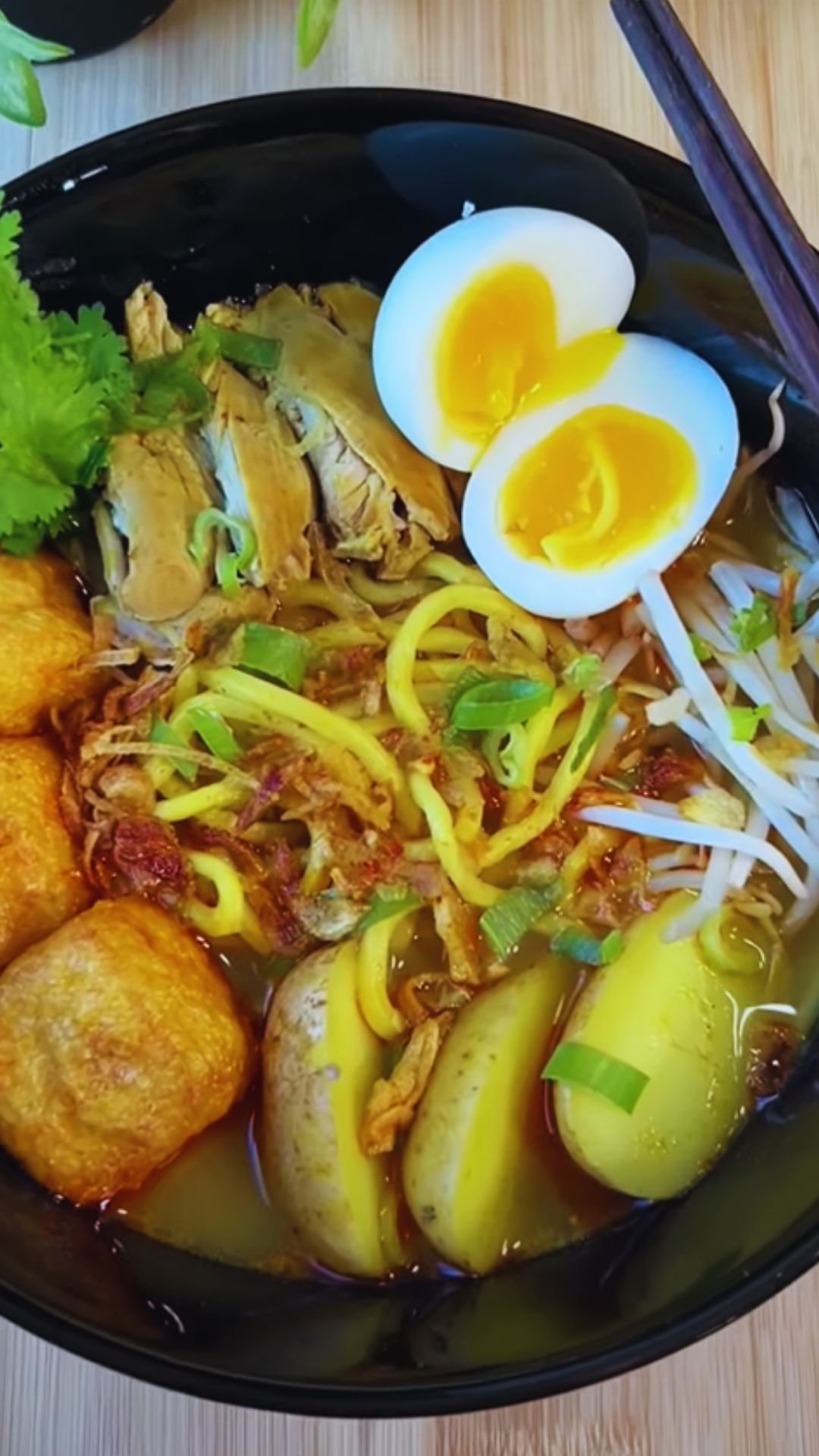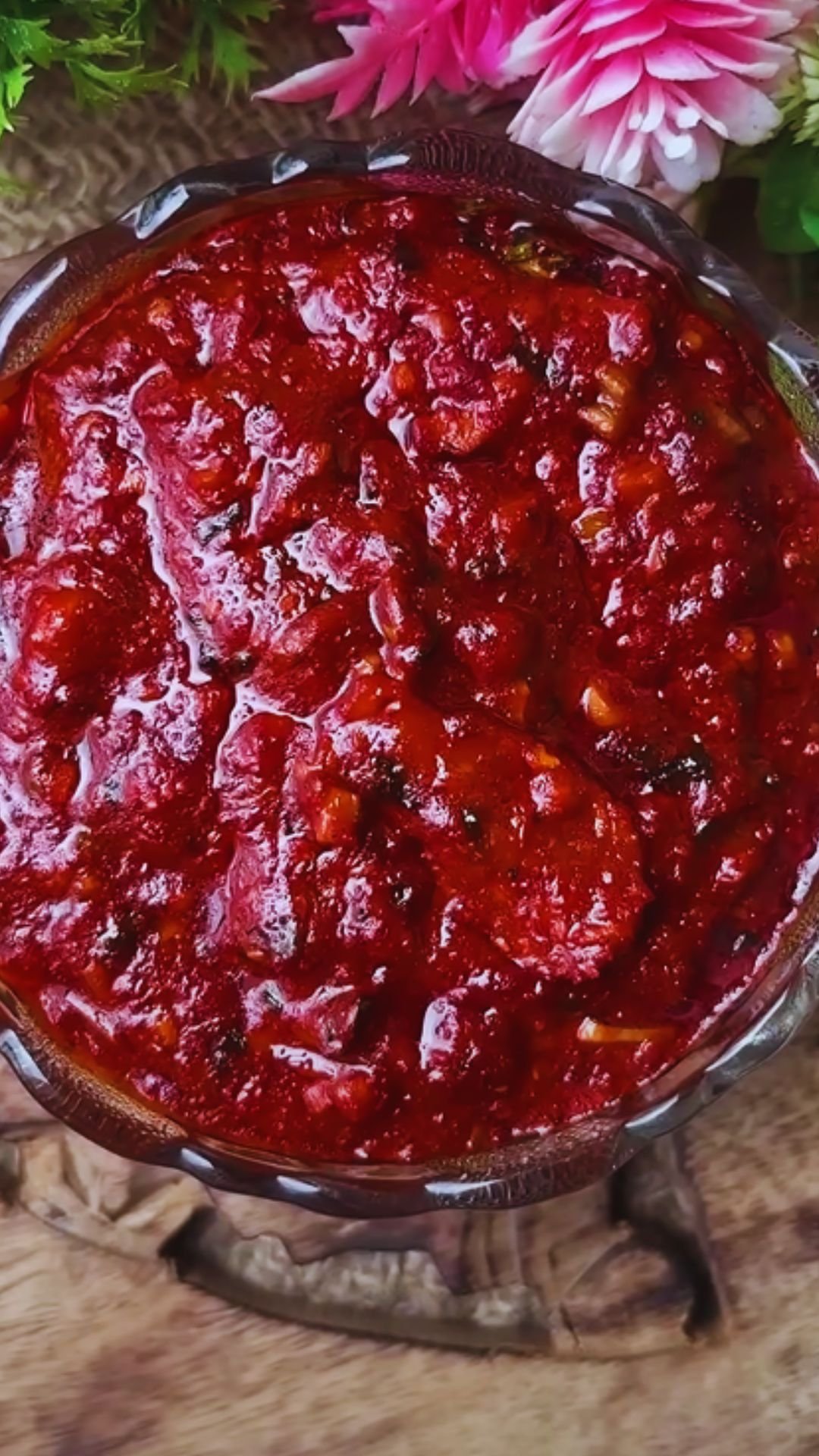There’s something magical about a steaming bowl of laksa that makes me feel like I’m transported straight to the bustling streets of Malaysia. The aromatic blend of spices, the richness of coconut milk, and the satisfying combination of noodles and toppings create a bowl of comfort that’s both exotic and soothing. After years of perfecting this recipe through countless taste tests and adjustments, I’m excited to share my authentic laksa soup recipe that brings all those vibrant Malaysian flavors right to your kitchen.
Laksa is more than just a soup – it’s a cultural icon in Southeast Asia, particularly in Malaysia, Singapore, and Indonesia. This spicy noodle soup combines Chinese and Malay culinary traditions, resulting in a dish that’s greater than the sum of its parts. Each region has its own variation, but today I’m focusing on the creamy, coconut-based version known as Curry Laksa or Nyonya Laksa.
What Makes Laksa Special?
What sets laksa apart from other noodle soups is its complex flavor profile. The dish balances spicy, sour, sweet, and savory elements, while the coconut milk provides a rich, creamy base that ties everything together. The laksa paste – a blend of chilis, lemongrass, galangal, turmeric, and other aromatics – forms the soul of this dish.
In my kitchen adventures, I’ve discovered that making laksa from scratch might seem intimidating at first, but it’s actually quite approachable when broken down into steps. The reward is an incredible depth of flavor that simply can’t be matched by shortcuts.
Ingredients
For the Laksa Paste:
- 6 dried red chilies, soaked in hot water for 15 minutes
- 4 fresh red chilies, roughly chopped
- 5 shallots, peeled and quartered
- 4 garlic cloves, peeled
- 2-inch piece of galangal, peeled and sliced
- 2-inch piece of ginger, peeled and sliced
- 2 stalks lemongrass, white part only, roughly chopped
- 1 tablespoon ground coriander
- 1 teaspoon ground cumin
- 1 teaspoon ground turmeric
- 5 candlenuts (or macadamia nuts as substitute)
- 1 tablespoon shrimp paste (belacan)
For the Soup:
- 3 tablespoons vegetable oil
- 2 tablespoons palm sugar (or brown sugar)
- 4 cups chicken stock
- 2 cups fish stock (or more chicken stock)
- 2 cans (13.5 oz each) coconut milk
- 2 tablespoons fish sauce
- 1 tablespoon tamarind paste
- 4 kaffir lime leaves, torn
- Salt to taste
Protein Options:
- 1 lb shrimp, peeled and deveined
- 8 oz firm tofu, cubed and fried (for vegetarian option)
- 12 oz boneless chicken thighs, sliced (optional)
- 8 oz fish cake slices (optional)
For Serving:
- 1 lb rice noodles (or egg noodles)
- 8 oz bean sprouts, blanched
- 1 cucumber, julienned
- 2 hard-boiled eggs, halved
- Fresh cilantro leaves
- Fresh mint leaves
- Sliced red chilies
- Lime wedges
- Crispy fried shallots
Equipment Needed
| Equipment | Purpose | Notes |
|---|---|---|
| Food processor or blender | Making laksa paste | A mortar and pestle works too but takes more effort |
| Large pot or Dutch oven | Cooking the soup | Choose one with 5-6 quart capacity |
| Fine mesh strainer | Straining stocks if needed | Helps create a smoother soup |
| Sharp knife | Ingredient prep | Good knife makes chopping aromatics easier |
| Cutting board | Ingredient prep | Preferably use separate ones for seafood |
| Measuring cups and spoons | Accurate measurements | Important for balanced flavors |
| Large bowl | Soaking noodles | Wide enough for noodles to soften evenly |
| Small frying pan | Toasting spices/frying toppings | Optional but enhances flavor |
Step-by-Step Instructions
Making the Laksa Paste:
- Prep the dried chilies: Remove stems and seeds from the soaked dried chilies.
- Combine ingredients: Place all laksa paste ingredients in a food processor or blender.
- Process to a paste: Blend until you achieve a smooth, thick paste. Add 1-2 tablespoons of water if needed to help the blending process.
- Adjust heat levels: For a milder paste, reduce the number of fresh chilies.
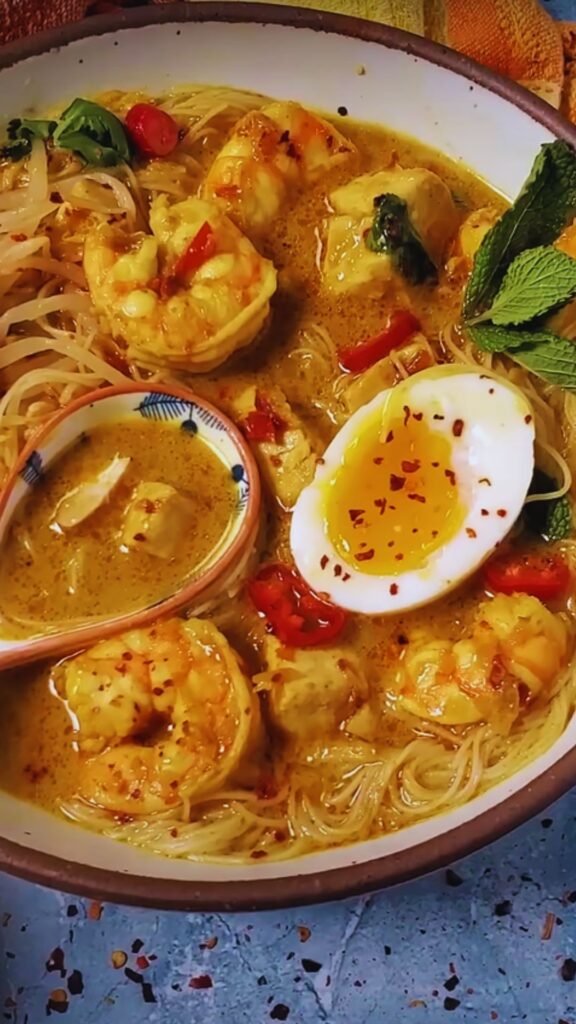
Cooking the Laksa:
- Heat the oil: In a large pot or Dutch oven, heat the vegetable oil over medium heat.
- Fry the paste: Add the laksa paste and fry for 8-10 minutes until fragrant and the oil begins to separate from the paste. This crucial step develops the flavors and removes the raw taste from the aromatics.
- Add palm sugar: Stir in the palm sugar and cook for another minute until dissolved.
- Add liquids: Pour in the chicken stock, fish stock, and coconut milk. Stir well to combine.
- Season the broth: Add fish sauce, tamarind paste, and torn kaffir lime leaves.
- Simmer: Bring to a gentle simmer (do not boil vigorously as this can cause the coconut milk to separate) and cook for 15-20 minutes to meld the flavors.
- Add protein:
- If using chicken: Add it now and simmer for 10 minutes until cooked through.
- If using shrimp: Add about 3 minutes before serving as they cook quickly.
- If using fish cake: Add in the last 5 minutes to warm through.
- If using fried tofu: Add in the last 5 minutes to absorb the flavors.
- Taste and adjust: Season with salt as needed. The broth should be well-balanced with spicy, sour, sweet, and savory notes.
Preparing the Noodles and Assembly:
- Cook noodles: Prepare rice noodles according to package instructions, typically soaking in hot water until soft but still slightly firm. Drain well.
- Blanch bean sprouts: Quickly dip bean sprouts in boiling water for 30 seconds, then drain and rinse with cold water to maintain crispness.
- Assemble the bowls: Place a portion of noodles in each serving bowl.
- Add the broth and protein: Ladle the hot laksa broth with your chosen protein over the noodles.
- Add toppings: Arrange bean sprouts, cucumber, half a boiled egg, cilantro, mint, and sliced chilies on top.
- Final touches: Sprinkle with crispy fried shallots and serve with lime wedges on the side.
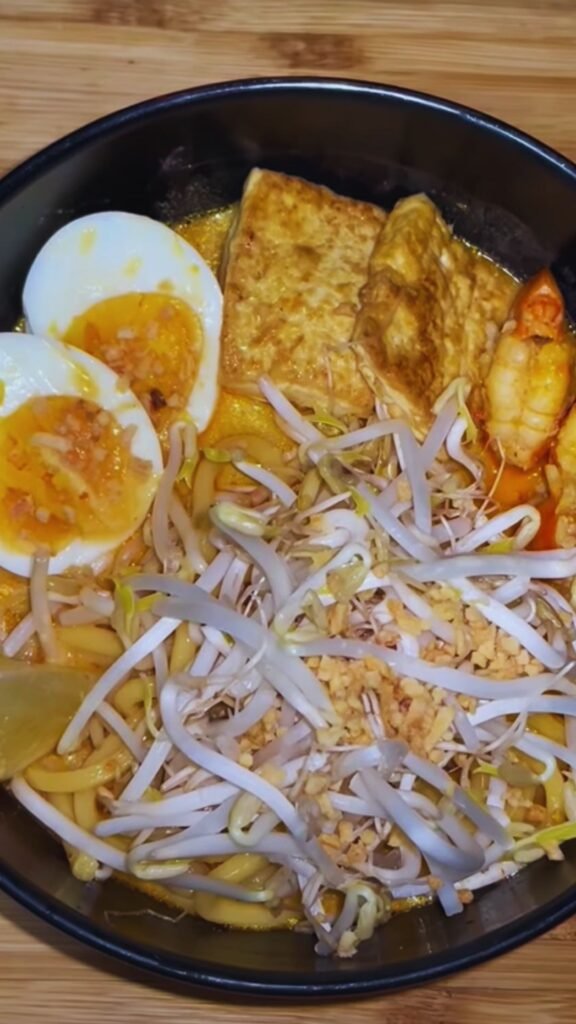
Regional Variations
Laksa comes in numerous regional variations across Southeast Asia. Here are some notable differences:
| Laksa Type | Region | Key Characteristics | Unique Ingredients |
|---|---|---|---|
| Curry Laksa | Kuala Lumpur | Coconut-based, spicy | Yellow noodles, bean curd puffs |
| Asam Laksa | Penang | Sour, fish-based | Mackerel, tamarind, mint |
| Laksa Lemak | Singapore | Coconut-rich, mild | Cockles, dried shrimp, laksa leaves |
| Sarawak Laksa | Sarawak | Sambal belacan, complex | Chicken, prawns, omelette strips |
| Johor Laksa | Johor | Thick gravy, spaghetti | Kerisik (toasted coconut), herbs |
| Laksam | Kelantan | Thick rice noodles, white gravy | Fish, coconut milk, ulam herbs |
Tips for Perfect Laksa
Making laksa is as much about technique as it is about ingredients. Here are my hard-earned tips to help you create the perfect bowl:
- Make extra paste: The laksa paste can be made in advance and stored in the refrigerator for up to a week, or frozen for up to 3 months. Having it on hand makes weeknight laksa possible.
- Don’t rush the paste frying: This step develops tremendous flavor. The paste should become fragrant and the oil should begin to separate – this takes at least 8-10 minutes.
- Use full-fat coconut milk: Light coconut milk simply won’t provide the rich, creamy texture that makes laksa special.
- Simmer, don’t boil: High heat can cause the coconut milk to separate. Keep the soup at a gentle simmer.
- Balance the flavors: Laksa should have a harmonious balance of spicy, sour, sweet, and savory. Adjust with more tamarind for sourness, palm sugar for sweetness, fish sauce for saltiness, or chili for heat.
- Prepare toppings in advance: Have all your toppings ready before assembling, as the soup is best served immediately while hot.
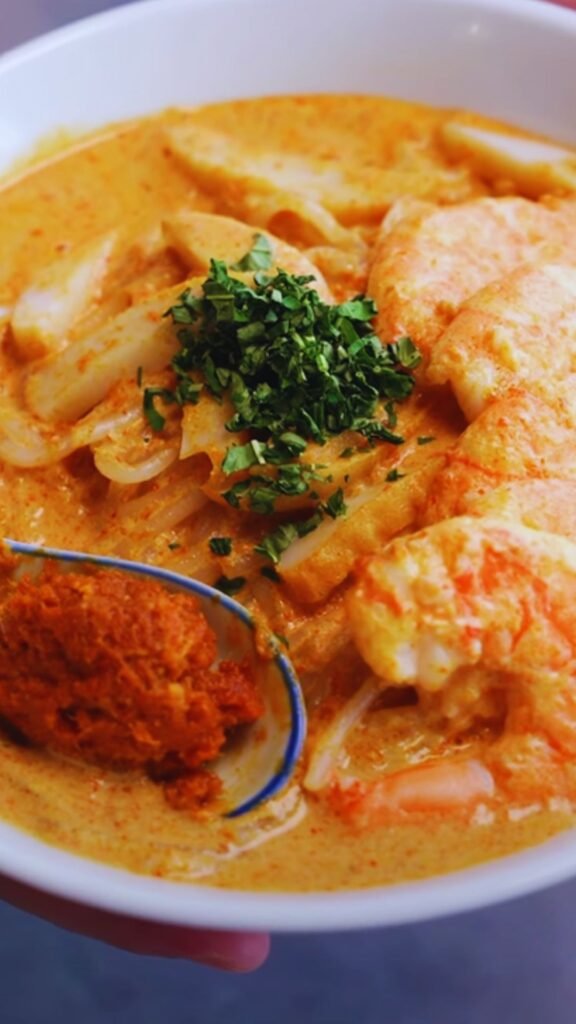
Nutritional Information
A typical serving of laksa soup contains:
| Nutrient | Amount | % Daily Value* |
|---|---|---|
| Calories | 650-750 | 32-38% |
| Total Fat | 42g | 54% |
| Saturated Fat | 28g | 140% |
| Cholesterol | 185mg | 62% |
| Sodium | 1450mg | 63% |
| Total Carbohydrate | 58g | 21% |
| Dietary Fiber | 5g | 18% |
| Sugars | 8g | – |
| Protein | 28g | 56% |
| Vitamin A | – | 45% |
| Vitamin C | – | 35% |
| Calcium | – | 12% |
| Iron | – | 25% |
*Based on a 2,000 calorie diet
Storage and Reheating
Laksa is best enjoyed fresh, but if you need to store leftovers:
- Store components separately: Keep the broth, noodles, and toppings in separate containers in the refrigerator.
- Broth storage: The laksa broth can be refrigerated for up to 3 days or frozen for up to 1 month.
- Noodle storage: Cooked noodles can be stored in the refrigerator for 1-2 days. Toss with a little oil to prevent sticking.
- Reheating: Gently reheat the broth on the stovetop until hot. Prepare fresh noodles if possible, or briefly reheat refrigerated noodles in hot water before assembling.
Serving Suggestions
Laksa is typically enjoyed as a complete meal on its own, but here are some complementary dishes and beverages you might consider:
- Roti canai: This flaky Malaysian flatbread is perfect for dipping in the laksa broth.
- Satay skewers: Grilled meat skewers make a great appetizer before the laksa.
- Cucumber salad: A simple cucumber salad dressed with rice vinegar provides a cooling contrast.
- Fresh fruit platter: End the meal with tropical fruits like mango, lychee, or rambutan.
- Beverages: Serve with iced tea, coconut water, or a refreshing lime juice.
Make It Your Own
While traditional laksa has specific components, don’t be afraid to customize based on your preferences or what’s available:
- Vegetarian option: Skip the shrimp paste in the laksa paste (substitute with miso paste), use vegetable stock instead of chicken/fish stock, and top with fried tofu, tempeh, or mushrooms.
- Protein swaps: Try sliced beef, duck, or seafood like squid or mussels.
- Noodle variations: Besides rice noodles, you can use egg noodles, udon, or even zucchini noodles for a low-carb option.
- Seasonal vegetables: Add seasonal vegetables like snow peas, bok choy, or spinach.
- Heat level: Adjust the number of chilies to make it as mild or spicy as you prefer.
The Cultural Significance of Laksa
Laksa isn’t just a delicious meal – it’s a dish that tells the story of Southeast Asia’s cultural history. Its origins reflect the region’s trading history and the blending of Chinese and Malay culinary traditions during the 15th century. The word “laksa” itself may come from the Sanskrit “laksha” meaning “many,” referring to the many ingredients in the dish.
In Malaysia and Singapore, laksa is more than street food – it’s a source of regional pride. Each area claims their variation is the most authentic and delicious. Food stalls specializing in laksa (called “laksa stalls”) are community institutions, with recipes passed down through generations, some guarded as closely as family treasures.
When making laksa at home, remember you’re participating in this rich culinary tradition that spans centuries and connects diverse cultures through the universal language of good food.
Common Problems and Solutions
| Problem | Possible Cause | Solution |
|---|---|---|
| Grainy or separated soup | Boiling the coconut milk | Keep heat low, never boil vigorously |
| Bland flavor | Insufficient frying of paste | Fry paste properly until fragrant and oil separates |
| Too spicy | Too many chilies | Add more coconut milk to dilute or serve with cucumber to cool palate |
| Too sour | Too much tamarind | Balance with a bit more palm sugar |
| Noodles too soggy | Oversoaked or left in broth too long | Prepare noodles just before serving and place in bowls before adding hot broth |
| Paste too thick to blend | Not enough liquid | Add a splash of water or oil while blending |
| Fishy taste too strong | Too much shrimp paste or fish sauce | Balance with more lime juice and herbs |
Q&A Section
What is the difference between Curry Laksa and Asam Laksa? Curry Laksa (what this recipe focuses on) uses coconut milk for a rich, creamy soup base and typically includes curry spices. Asam Laksa, on the other hand, has a sour fish-based broth made with tamarind, doesn’t use coconut milk, and has a completely different flavor profile despite sharing the same name.
Can I make laksa paste ahead of time? Absolutely! Laksa paste can be made up to one week in advance and stored in an airtight container in the refrigerator. For longer storage, freeze it in ice cube trays, then transfer the frozen cubes to a freezer bag. They’ll keep for up to 3 months.
Is there a shortcut version for busy weeknights? While homemade paste provides the best flavor, you can find premade laksa paste in Asian markets or online. To enhance store-bought paste, sauté it with fresh lemongrass, ginger, and garlic before adding the liquids.
What can I substitute for hard-to-find ingredients? Here are some common substitutions:
- Galangal: Use extra ginger with a pinch of pepper
- Kaffir lime leaves: Substitute with lime zest
- Belacan (shrimp paste): Use fish sauce or miso paste (for vegetarian option)
- Candlenuts: Macadamia nuts or cashews work well
- Tamarind paste: Mix lime juice with a touch of brown sugar
How can I make a vegetarian or vegan laksa? For vegetarian laksa, use vegetable stock, omit the shrimp paste (substitute with miso), and use tofu or tempeh instead of seafood or chicken. For vegan laksa, also ensure your noodles don’t contain egg and omit the egg garnish.
Why is my laksa soup not as red/orange as restaurant versions? Commercial versions often add food coloring or extra turmeric. The natural color of homemade laksa can range from orange-red to yellowish-brown depending on the chilies and turmeric used. The flavor is more important than achieving a specific color.
How spicy is authentic laksa? Traditional laksa is moderately spicy, but heat levels vary greatly by region and personal preference. Start with fewer chilies if you’re sensitive to spice, as you can always add sambal or fresh chilies at the table.
Can I use a different protein? Absolutely! Laksa is incredibly versatile. Try it with sliced beef, squid, fish fillets, mussels, or even duck. Just adjust cooking times according to the protein chosen.
A Final Note
Making laksa at home connects you to a rich culinary tradition that spans centuries and crosses cultural boundaries. While it may seem complex at first glance, the process is actually quite straightforward and the results are well worth the effort. The beauty of laksa lies in its adaptability – once you understand the basic principles, you can adjust the recipe to suit your taste preferences and available ingredients.
Remember that like many traditional dishes, laksa is forgiving. Don’t worry if you can’t find every authentic ingredient – the soul of laksa is in its balanced flavors and the care you put into preparing it. I hope this recipe brings a taste of Malaysian street food culture to your home kitchen and inspires you to explore more Southeast Asian cuisine!

